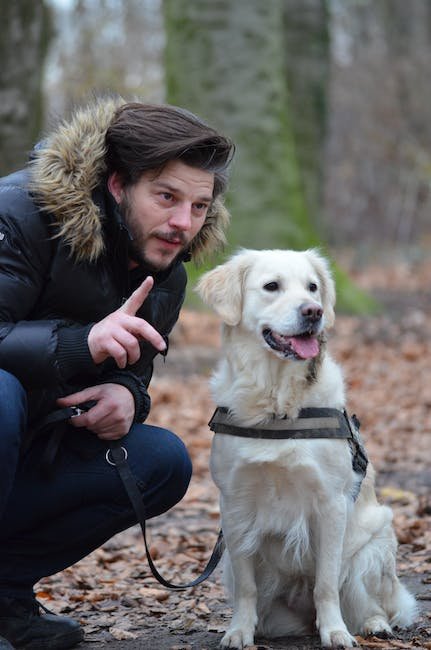In the vast world of dog training, where commands like “sit” and “fetch” have become commonplace, there are pet owners who strive for more extraordinary feats from their beloved furry companions. From dancing to painting, dogs have proven themselves as incredibly versatile creatures, capable of learning remarkable skills. However, one particular trick has recently gained attention and is sweeping through the dog training community: The “Identify Colors” trick. Unveiling an unexplored realm of canine ability, this advanced training technique promises to take your four-legged friend’s brilliance to captivating new heights. Prepare to be amazed as we embark on a journey to uncover the secrets behind this mesmerizing skill that will leave you and your dog basking in awe.
Table of Contents
- Understanding the Concept of Color Identification in Dog Training
- Key Factors to Consider before Teaching Your Dog to Identify Colors
- Step-by-Step Training Guide for Teaching Your Dog the “Identify Colors” Trick
- Tips and Troubleshooting: Overcoming Challenges in Color Recognition Training
- Taking Color Identification Training to the Next Level: Advanced Techniques and Exercises
- Q&A
- In Summary

Understanding the Concept of Color Identification in Dog Training
When it comes to dog training, color identification is an important concept that can make a significant difference in communication between the handler and the furry companion. Understanding how dogs perceive colors can allow you to utilize color cues effectively in training sessions and daily interactions.
While it is commonly believed that dogs see the world in black and white, this is not entirely true. Dogs do have color vision, although it is not as vibrant as that of humans. Their visual spectrum is limited to blues, yellows, and shades of gray, with an inability to distinguish between reds and greens. This knowledge is pivotal in designing training methods and using color-coded cues that dogs can readily identify.
To leverage color identification in dog training, here are some strategies you can try:
- Color-coded toys and targets: Use brightly colored toys or designated targets marked with distinctive hues to guide your dog’s attention and enhance their focus during training exercises.
- Visual aids: Incorporate visual aids, such as colored flags or cones, into training routines. These can indicate specific zones or routes for your dog, reinforcing their learning and associating commands with color cues.
- Color-based commands: Rather than relying solely on verbal cues, teach your dog to respond to color commands. For example, associate the color blue with “sit” and yellow with “stay,” allowing for clear and consistent communication with your four-legged friend.
Understanding color identification in dog training provides invaluable insights into how our canine companions perceive the world. By utilizing colors effectively, we can enhance their learning experience and strengthen the bond between humans and dogs.

Key Factors to Consider before Teaching Your Dog to Identify Colors
Teaching your dog to identify colors can be both fun and rewarding. However, before embarking on this exciting journey, there are several important factors to consider to ensure a successful training experience for both you and your furry friend.
- Patience is key: Training your dog to identify colors requires time and consistency. Remember that dogs learn at their own pace, so be patient and avoid rushing the process. Celebrate small victories along the way, and remember that positive reinforcement goes a long way in motivating your dog.
- Choose the right materials: Before starting color training, make sure you have the necessary supplies. Opt for a set of colored objects or toys that are easily distinguishable from one another. This will help your dog differentiate between colors more efficiently.
- Ensure a distraction-free environment: Dogs are easily distracted, so finding a quiet and calm space to conduct training sessions is crucial. Minimize any potential interruptions, such as noise or other pets, to maintain your dog’s focus and engagement during the training process.
By keeping these key factors in mind, you will create an environment that is conducive to your dog’s learning and set the stage for a successful journey in teaching your pet to identify colors.

Step-by-Step Training Guide for Teaching Your Dog the “Identify Colors” Trick
Welcome to our . This fun and interactive trick will not only impress your friends but also stimulate your dog’s cognitive abilities. So, grab some treats, gather your furry friend, and let’s get started!
Materials needed:
- A variety of colored objects, such as toys or plastic cups
- Treats or rewards that your dog loves
- A clicker (optional but helpful for reinforcement)
Step 1: Introduce the concept of colors
Start by familiarizing your dog with different colors. Hold up one colored object and encourage your dog to sniff it or give it a gentle touch with their nose or paw. As they interact with the object, use a verbal cue like “touch” or “sniff.” Repeat this process with objects of different colors, always rewarding your dog with treats and verbal praise for their engagement.
Step 2: Associate colors with verbal cues
Once your dog is comfortable interacting with the colored objects, it’s time to introduce the concept of color names. Choose one color and its object, for example, a red toy. Hold up the red toy and say the word “red” clearly and consistently. Repeat this exercise several times, ensuring your dog associates the word “red” with the object through repetition and treats.
Step 3: Test and reinforce
Now it’s time to put your dog’s knowledge to the test. Mix up the colored objects and ask your dog to “find” a specific color. For instance, say “Find the blue toy” while holding up a blue object. Encourage your dog to touch or pick up the correct object, and reward them enthusiastically when they do. Gradually increase the difficulty by introducing more colors and reinforcing their understanding of each color’s name.
Remember, consistency and patience are key during this training process. Celebrate every small success and always end each session on a positive note. With practice and dedication, you and your dog will soon be impressing everyone with their ability to identify colors!
Tips and Troubleshooting: Overcoming Challenges in Color Recognition Training
Color recognition training can be a fun and interactive way to teach young children about different colors. However, like any learning process, there can be challenges along the way. Here are some tips and troubleshooting techniques to help you overcome these hurdles:
- Engage multiple senses: Incorporate various sensory experiences to enhance color recognition. For example, encourage children to touch different objects of the same color or associate each color with a unique smell or taste. By engaging multiple senses, you’ll make the learning process more memorable and enjoyable.
- Use real-life examples: To help children understand the concept of colors better, provide real-life examples that they can relate to. Point out colorful objects in their everyday environment, such as fruits, flowers, or toys. By connecting colors to familiar objects, children can build stronger associations and learning becomes more meaningful.
- Offer repetition and reinforcement: Repetition is key when it comes to learning, especially for young minds. Ensure you provide ample opportunities for children to practice color recognition. Use flashcards, puzzles, or interactive games that focus on identifying and matching colors. Regular reinforcement will strengthen their understanding and make color recognition second nature.
While encountering challenges during color recognition training is normal, the journey can be an exciting one with these helpful tips. Remember to be patient, provide positive reinforcement, and celebrate each milestone. With perseverance, children will develop a solid understanding of colors and enjoy exploring the vibrant world around them.
Taking Color Identification Training to the Next Level: Advanced Techniques and Exercises
Advanced Techniques:
- Color Grading: Take your color identification skills to the next level by learning how to grade colors. This technique involves differentiating between shades and tones within a color spectrum. With practice, you’ll be able to identify subtle differences and accurately classify them.
- Advanced Color Matching: Challenge yourself with intricate color matching exercises. These exercises will test your ability to identify harmonious color combinations and create visually pleasing compositions. You’ll gain a deeper understanding of how colors interact and how to effectively utilize them in various design projects.
- Color Psychology: Unlock the power of color psychology and its impact on emotions and behavior. Learn how different colors can evoke specific feelings and moods, and discover how to strategically use this knowledge in branding, marketing, and design. Explore the significance of color in cultures and societies, and how it can influence perceptions and experiences.
Exercises:
- Color Blindness Simulation: Experience and understand color blindness by using special simulation tools or software. This exercise will help you develop empathy and consideration for individuals who perceive colors differently. It will also enhance your ability to adapt and create inclusive designs that cater to diverse audiences.
- Color Manipulation Challenges: Push your creativity to new limits by participating in color manipulation challenges. These exercises involve transforming and altering colors while maintaining their intended purpose and impact. By experimenting with different hues, saturations, and contrasts, you’ll develop a keen eye for color variations and expand your artistic versatility.
- Color Explorations: Dive into the world of color exploration and experimentation. Engage in projects where you have the freedom to play with color combinations, textures, and patterns. This hands-on approach will help you discover unique color schemes and develop a personal style that reflects your individuality and creativity.
Q&A
Q: How can I teach my dog to identify colors?
A: Teaching your dog to identify colors is a fun and unique trick that involves associating each color with a specific object or command. Through consistent training and positive reinforcement, you can gradually teach your dog to distinguish between different colors.
Q: Is it possible for all dogs to learn this trick?
A: Yes! Any dog, regardless of breed or age, can learn the “identify colors” trick. However, it may take more time for some dogs to grasp the concept, so patience and persistence are key.
Q: What are the first steps to train my dog to identify colors?
A: Start by selecting three or four easily distinguishable colors, and associate each color with a unique command or object. Use treats and positive reinforcement to introduce your dog to the colors, rewarding them each time they correctly identify the color you ask for.
Q: Should I use specific objects or cards for color recognition training?
A: You can use specific objects, such as balls or toys, as visual aids for color recognition training. Alternatively, you can also opt for colored cards or pieces of fabric. Choose a method that works best for you and your dog’s training style.
Q: How long does it usually take for a dog to learn this trick?
A: The learning speed varies for each dog. Some may take a few weeks to grasp the concept, while others may require more time. Consistency, repetition, and positive reinforcement are essential for successful training.
Q: Can I incorporate the “identify colors” trick into daily activities?
A: Absolutely! Once your dog has learned the trick, you can integrate it into daily activities, such as having them fetch a specific colored toy or pointing out colors during walks. This provides mental stimulation and strengthens the bond between you and your furry friend.
Q: What are the benefits of teaching my dog to identify colors?
A: Teaching your dog this trick enhances their cognitive abilities, mental stimulation, and overall responsiveness to commands. It also adds an element of fun and novelty to training sessions, promoting a positive training experience for both you and your dog.
In Summary
As we bid farewell to this exploration into the enchanting world of advanced dog training, let us marvel at the extraordinary feat of the “Identify Colors” trick. Our furry companions have once again proven their intelligence knows no bounds, showcasing their ability to discern the vibrant spectrum that graces our daily lives.
Through patience, perseverance, and a sprinkle of paw-some guidance, dogs have ventured into realms only imagined in the wildest of dreams. From discerning between crimson and sapphire, to unraveling the mysteries of lavender and emerald, these magnificent creatures have undoubtedly left us in awe of their potential.
As we conclude this article on advanced dog training, let us not forget the profound bond forged between human and canine. It is a testament to the sheer brilliance of these four-legged geniuses that they can unravel the secret language of color, bridging the gap between our worlds. For that, we owe them our utmost respect, admiration, and endless treats.
Now, armed with new insights and appreciation for our faithful companions, may we continue this extraordinary journey of expanding the boundaries of dog-human communication. Let us remind ourselves that within their paws lies an uncharted universe, waiting to be explored, waiting to astound us once again.
So, dear reader, let us venture forth with determination and wonder, continuing to unlock the hidden potential of our beloved companions. For in sharing this wondrous path with our dogs, we unlock not only a world of extraordinary tricks but also a lifetime of precious memories, boundless love, and limitless joy.
Until we embark on our next awe-inspiring quest, always remember the power that lies within the paws of our furry friends. They are, without a doubt, the true magicians in this grand stage of life.
As an affiliate, my content may feature links to products I personally use and recommend. By taking action, like subscribing or making a purchase, you’ll be supporting my work and fueling my taco cravings at the same time. Win-win, right?
Want to read more? Check out our Affiliate Disclosure page.
